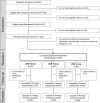Effects of Sugar-Sweetened, Artificially Sweetened, and Unsweetened Beverages on Cardiometabolic Risk Factors, Body Composition, and Sweet Taste Preference: A Randomized Controlled Trial
- PMID: 32696704
- PMCID: PMC7792240
- DOI: 10.1161/JAHA.119.015668
Effects of Sugar-Sweetened, Artificially Sweetened, and Unsweetened Beverages on Cardiometabolic Risk Factors, Body Composition, and Sweet Taste Preference: A Randomized Controlled Trial
Abstract
Background A 2018 American Heart Association science advisory indicated that, pending further research, artificially sweetened beverages (ASBs) may be an appropriate initial replacement for sugar-sweetened beverages (SSBs) during transition to unsweetened beverages (USBs). Methods and Results We randomly assigned 203 adults (121 males, 82 females; 91.6% retention), who habitually consumed SSBs, to 3 groups and delivered free SSBs, ASBs, or USBs to their homes for 12 months. Outcomes included serum triglyceride to high-density lipoprotein cholesterol ratio (primary), body weight, and sweet taste preference (experimental assessment, 0%-18% sucrose solutions). Change in serum triglyceride to high-density lipoprotein cholesterol ratio was not different between groups. Although overall change in weight also was not different between groups, we found effect modification (P=0.006) by central adiposity. Among participants in the highest tertile of baseline trunk fat but not other tertiles, weight gain was greater (P=0.002) for the SSB (4.4±1.0 kg, estimate±SE) compared with ASB (0.5±0.9 kg) or USB (-0.2±0.9 kg) group. Both sweetness threshold (-1.0±0.2% m/v; P=0.005) and favorite concentration (-2.3±0.4% m/v; P<0.0001) decreased in the USB group; neither changed in the SSB group. In the ASB group, sweetness threshold did not change, and favorite concentration decreased (-1.1±0.5% m/v; P=0.02). Pairwise comparison between the ASB and USB groups indicated a difference in sweetness threshold (P=0.015). Conclusions Replacing SSBs with noncaloric beverages for 12 months did not affect serum triglyceride to high-density lipoprotein cholesterol ratio. Among individuals with central adiposity, replacing SSBs with either ASBs or USBs lowered body weight. However, USBs may have the most favorable effect on sweet taste preference. Registration URL: https://www.clinicaltrials.gov; unique identifier: NCT01295671.
Keywords: beverages; body weight; diet; dyslipidemia; sweet taste preference.
Conflict of interest statement
Dr Ludwig received royalties for books on obesity and nutrition that recommend a low‐glycemic‐load diet. The remaining authors have no disclosures to report.
Figures



References
-
- Johnson RK, Appel LJ, Brands M, Howard BV, Lefevre M, Lustig RH, Sacks F, Steffen LM, Wylie‐Rosett J. Dietary sugars intake and cardiovascular health: a scientific statement from the American Heart Association. Circulation. 2009;120:1011–1020. - PubMed
-
- U.S. Department of Health and Human Services and U.S. Department of Agriculture . Dietary Guidelines for Americans 2015 ‐ 2020. 8th ed December 2015. Available at: http://health.gov/dietaryguidelines/2015/guidelines/. Accessed October 31, 2019.
-
- Johnson RK, Lichtenstein AH, Anderson CAM, Carson JA, Despres JP, Hu FB, Kris‐Etherton PM, Otten JJ, Towfighi A, Wylie‐Rosett J. Low‐calorie sweetened beverages and cardiometabolic health: a science advisory from the American Heart Association. Circulation. 2018;138:e126–e140. - PubMed
Publication types
MeSH terms
Substances
Associated data
Grants and funding
LinkOut - more resources
Full Text Sources
Medical

